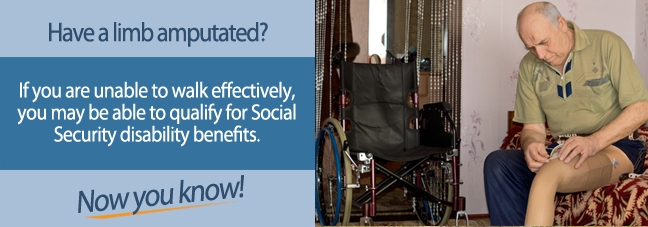Over 1.8 million Americans are currently living with amputations of some kind. Caused by infection, trauma, frostbite, and many other health issues, amputations of all kinds are life-changing and can require time and accommodations to adjust.
Unfortunately, some cases are too severe to continue working and living a normal life. However, for those need of assistance, Social Security disability benefits may be an answer. Look below to see if your amputation may qualify for disability benefits.
Step One: Determine how much your amputation limits you.
Depending on the severity, an amputation may cause several major changes to your lifestyle. When the Social Security Administration (SSA) determines if you qualify for benefits, they need to know how much these changes prevent you from working and taking care of yourself.
For instance: if you suffered from an accident that caused the amputation of your right leg above the knee, it may be difficult for you to get around, even with a prosthetic. Especially if you held physically-demanding past jobs, such as construction or landscaping, this amputation would prevent you from performing as before. Even within the home, things like yard work and cleaning could become a challenge, further demonstrating a need for assistance.
The more your amputation prevents you from providing for yourself as before, the more Social Security is likely to award monthly benefits to help.
Step Two: Consult the Blue Book and retrieve test results confirming the severity of your condition.
When evaluating applications, the SSA refers to the “Blue Book”. The book contains descriptions of all Social Security-approved disabilities and the tests required to be approved for them. For example, those who have had both hands amputated, the amputation of one leg up to the hip, or the amputation of both legs may automatically qualify for disability benefits.
For those whose amputations are not listed in the Blue Book, you are not disqualified from receiving benefits. This just means that, when applying, it is important to include as much medical evidence as possible to the SSA to prove that your amputation requires assistance. Evidence may include x-rays, CT scans, limited mobility tests, and functionality assessments, all which can be provided by your physician.
Step Three: Gather tax info, work history, and prepare to fill out the application.
The Social Security disability application requires all information that gives insight onto your life and how your illness affects you, such as tax info and work history.
Tax information allows the SSA to see how much money you have contributed to Social Security in the years you’ve been working. Depending on your age, you must have contributed a certain amount to qualify for disability insurance.
Work history is also provided to show the SSA what types of work you have experience in, when/if you stopped working, and whether or not your amputation prevents you from working similar jobs. It is also best to have as much documentation on hand as possible (Social Security number, addresses, references, etc.) before beginning the application.
Contacting a Social Security Attorney
While it is possible to complete the process yourself, applying for disability can sometimes be overwhelming. If you feel that you may qualify for disability benefits, it is wise to consult with a disability advocate or attorney. They are an irreplaceable resource when filing out applications, keeping paperwork organized, and aiding you in the appeals process if necessary. It is also required by law that disability attorneys do not receive payment unless you win your case.
To give yourself the best chance at receiving the assistance you deserve, speak with a disability attorney today.
